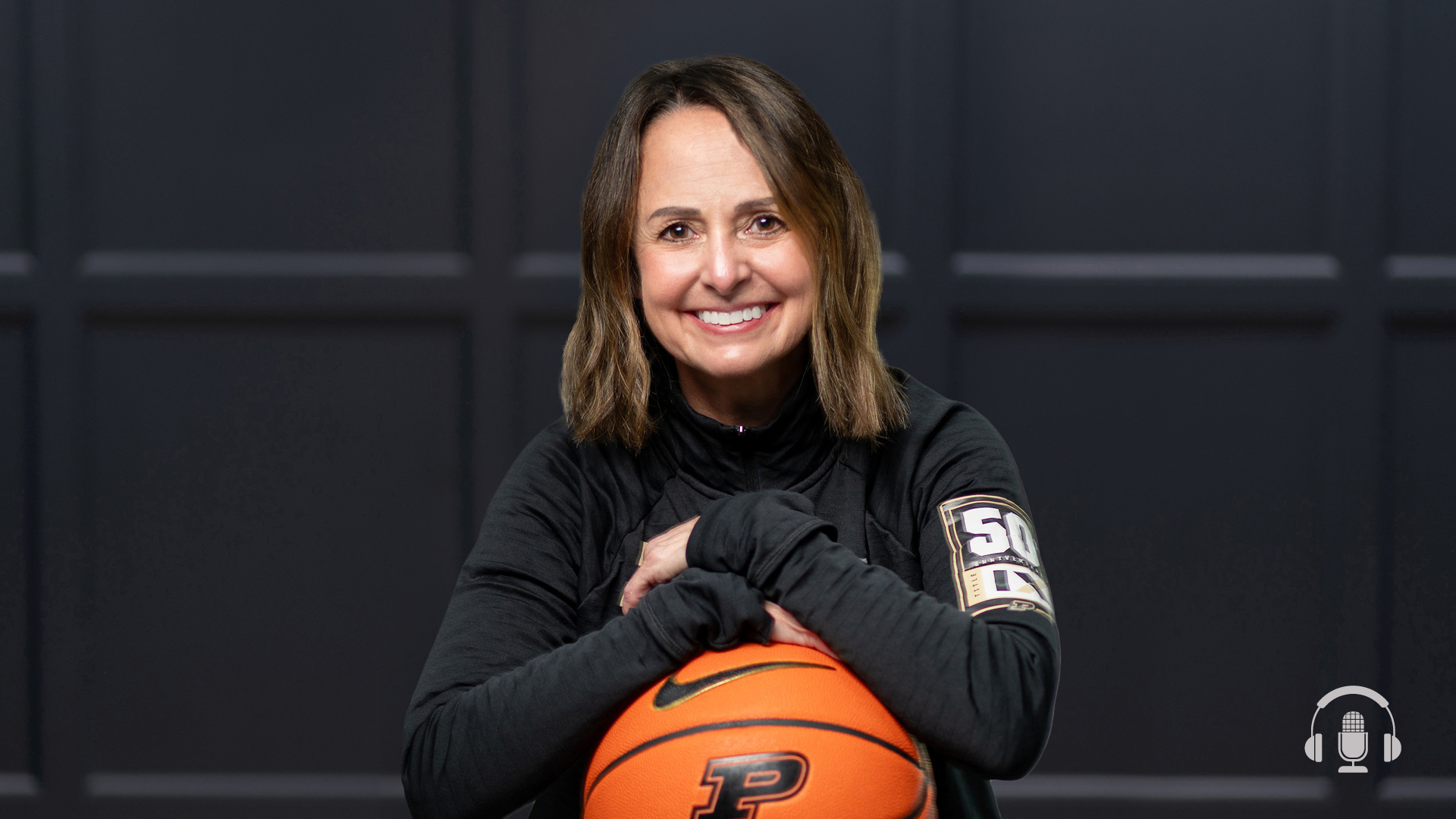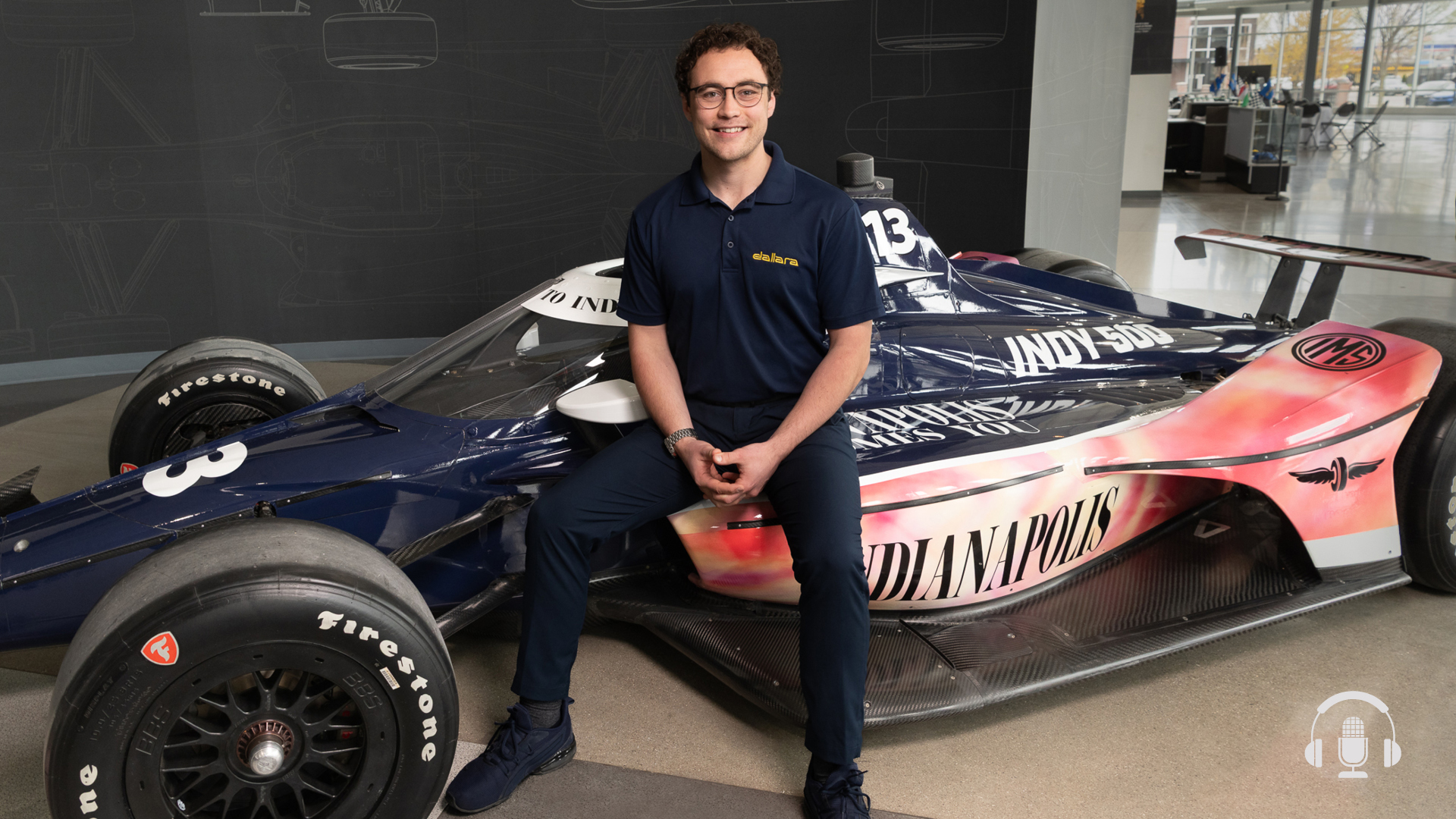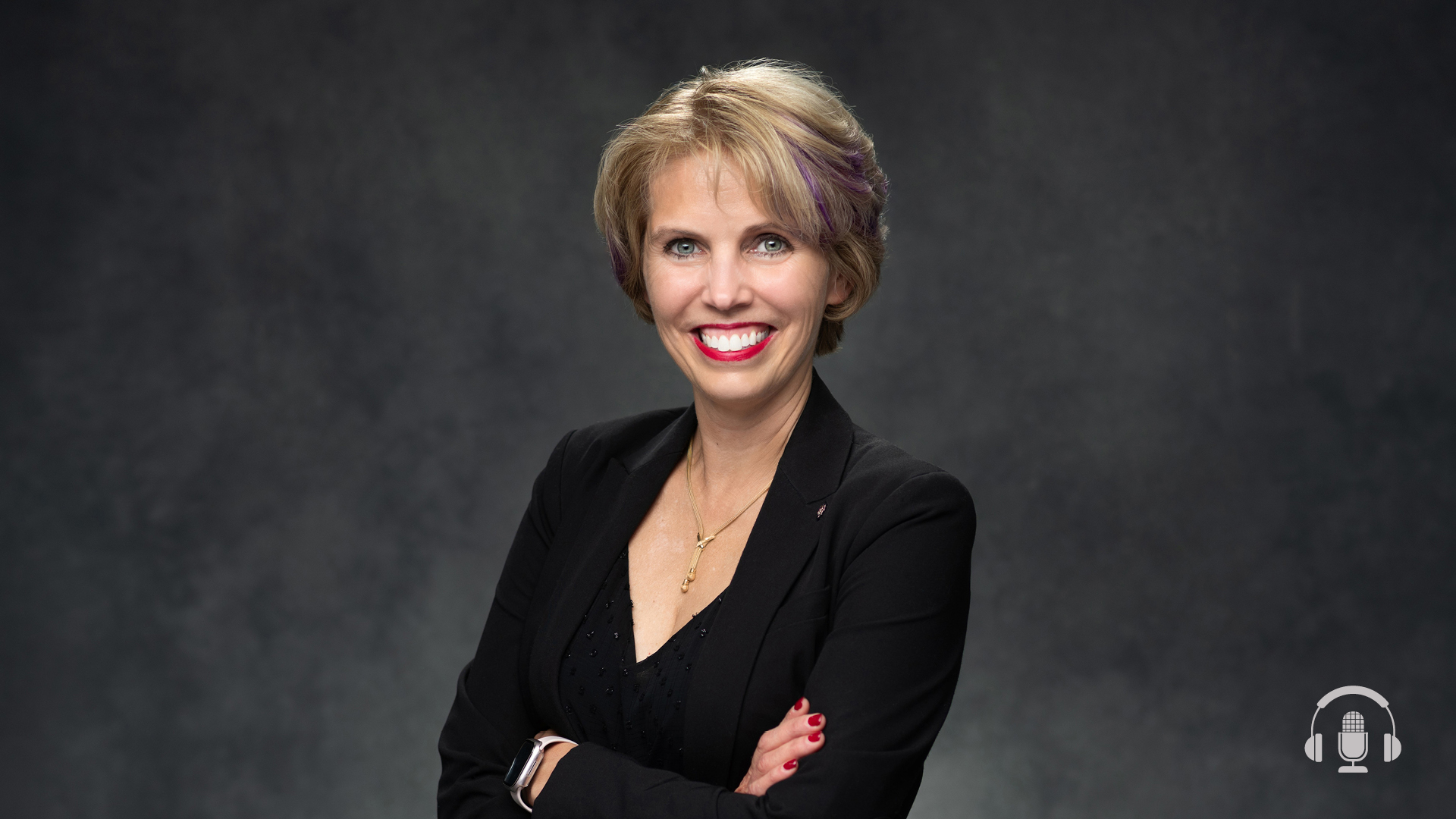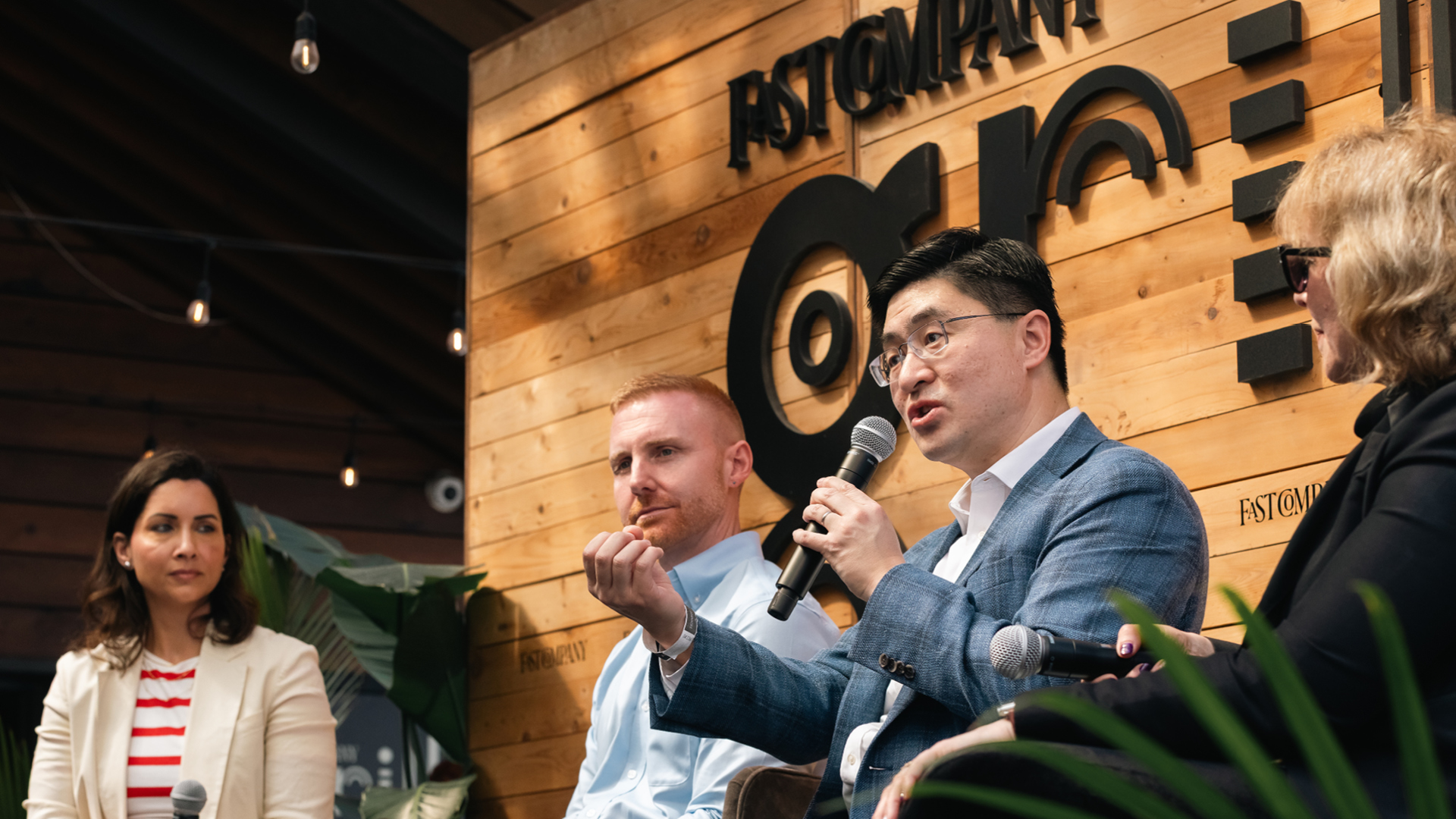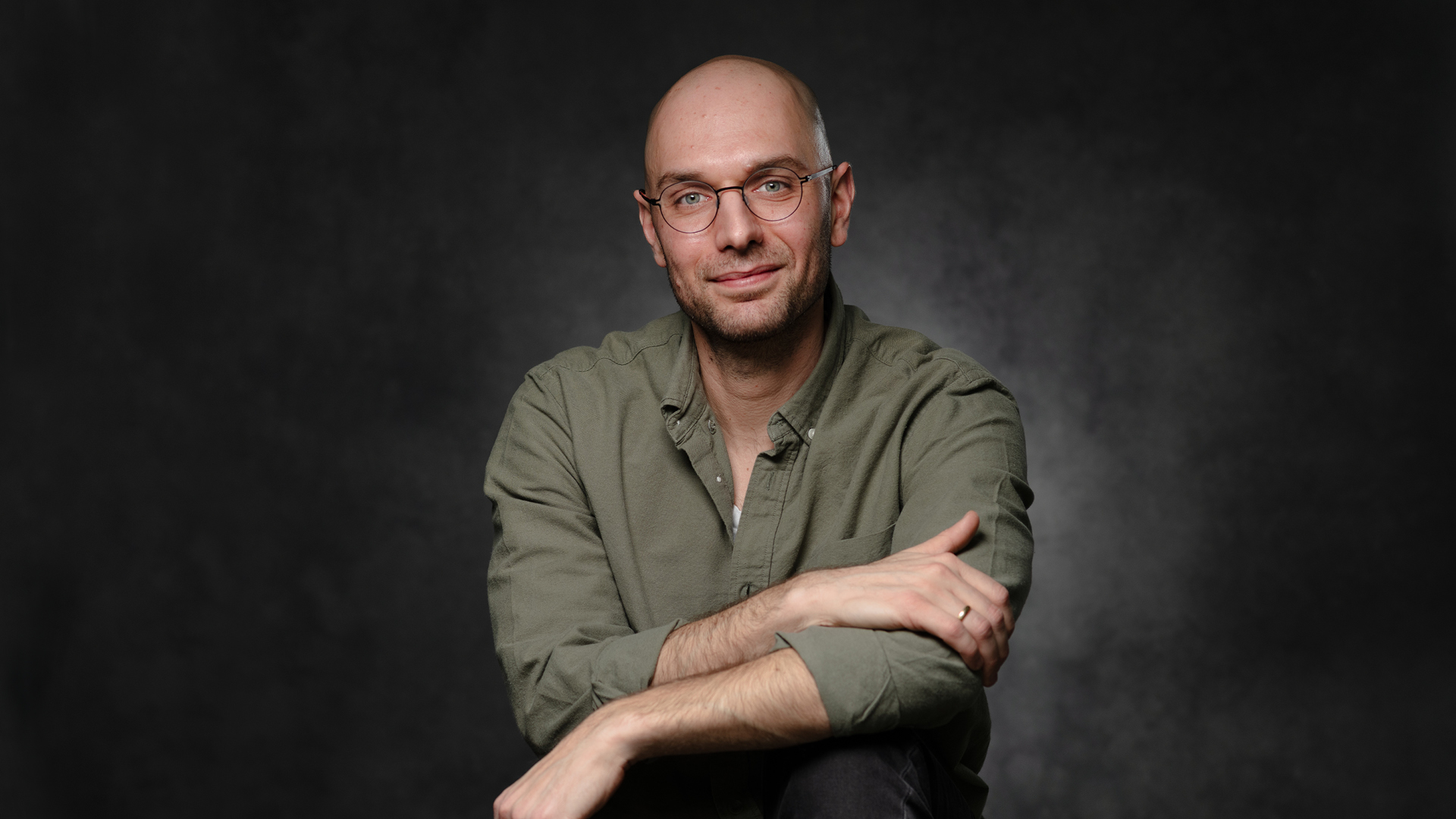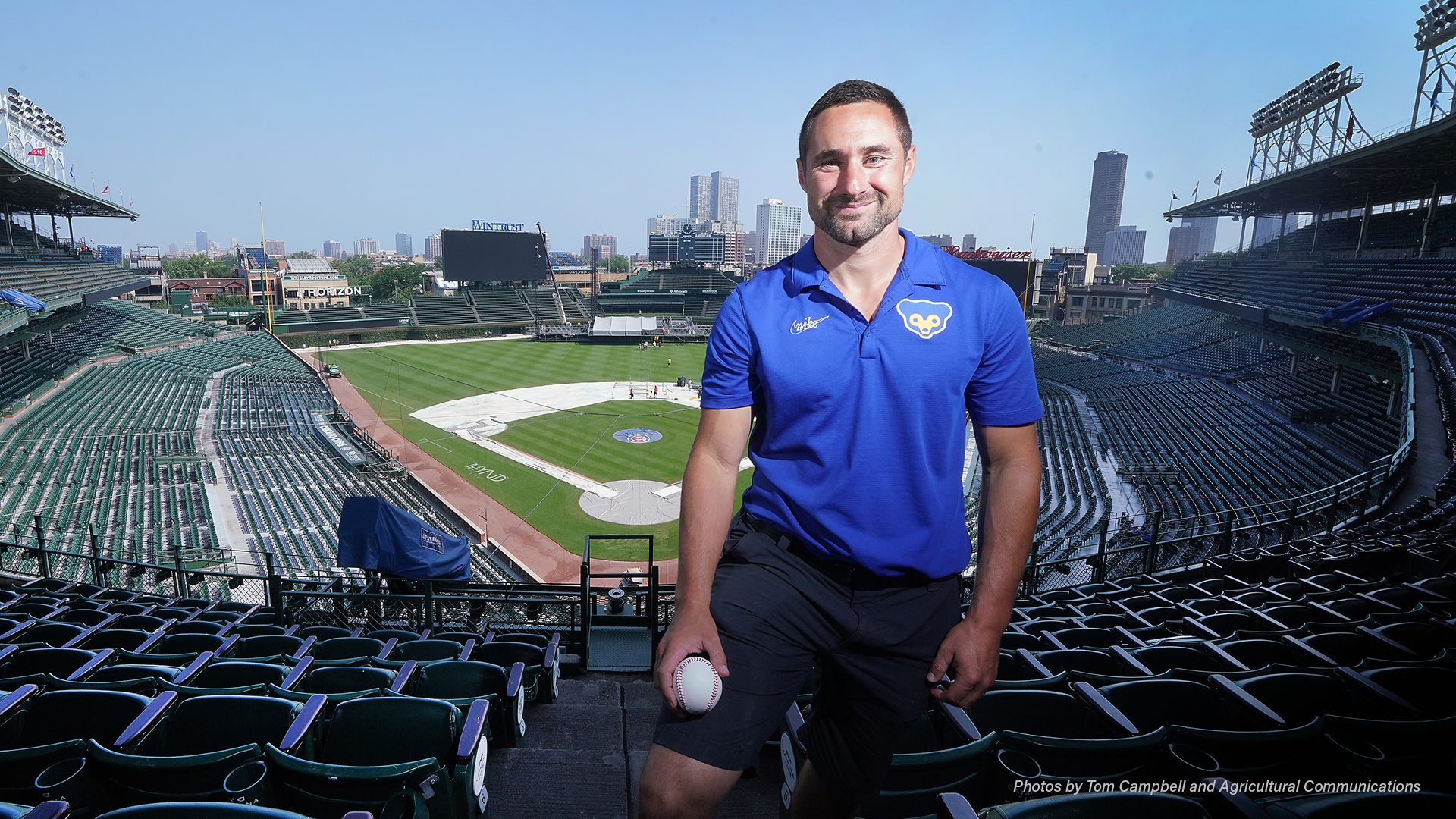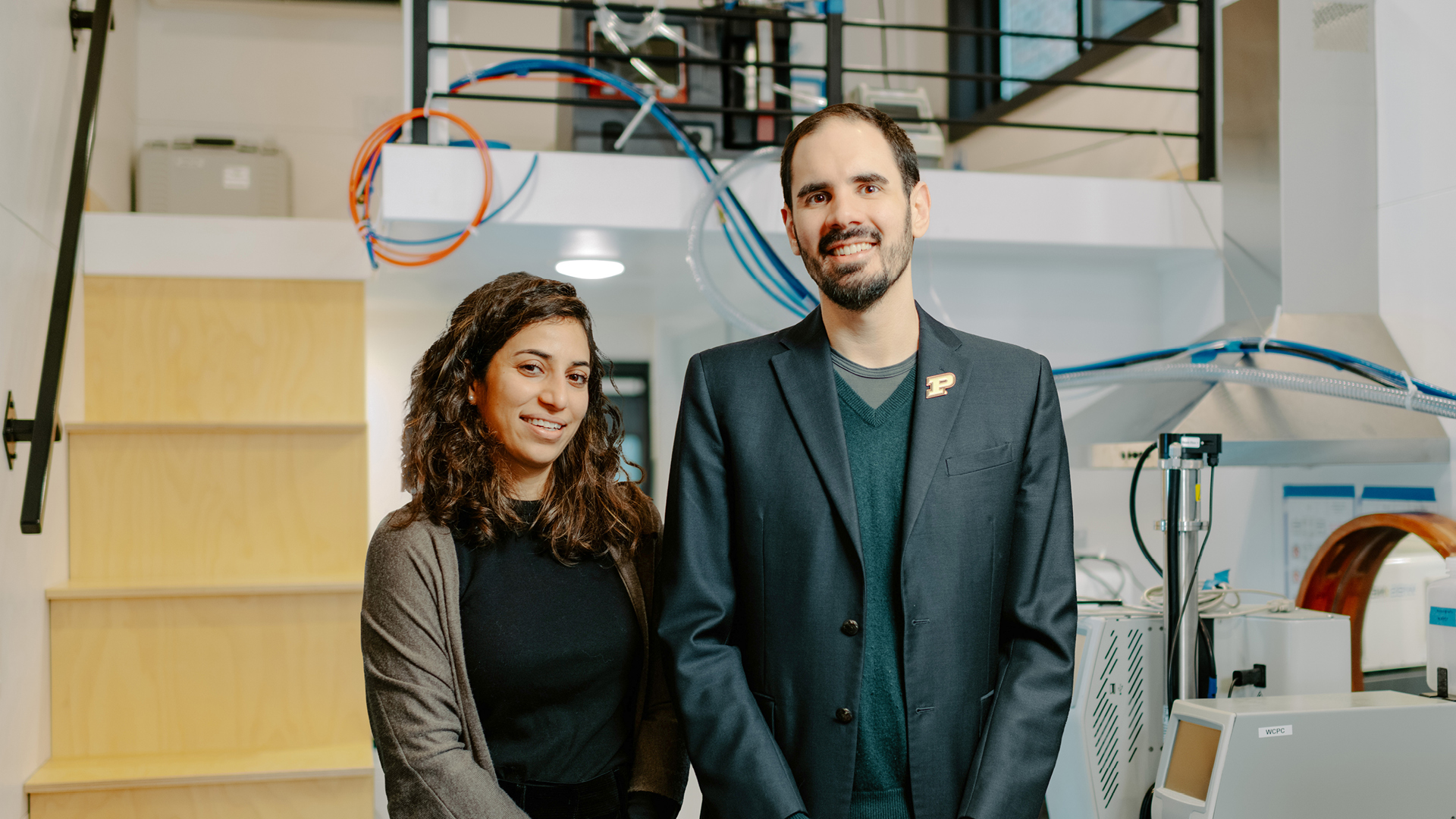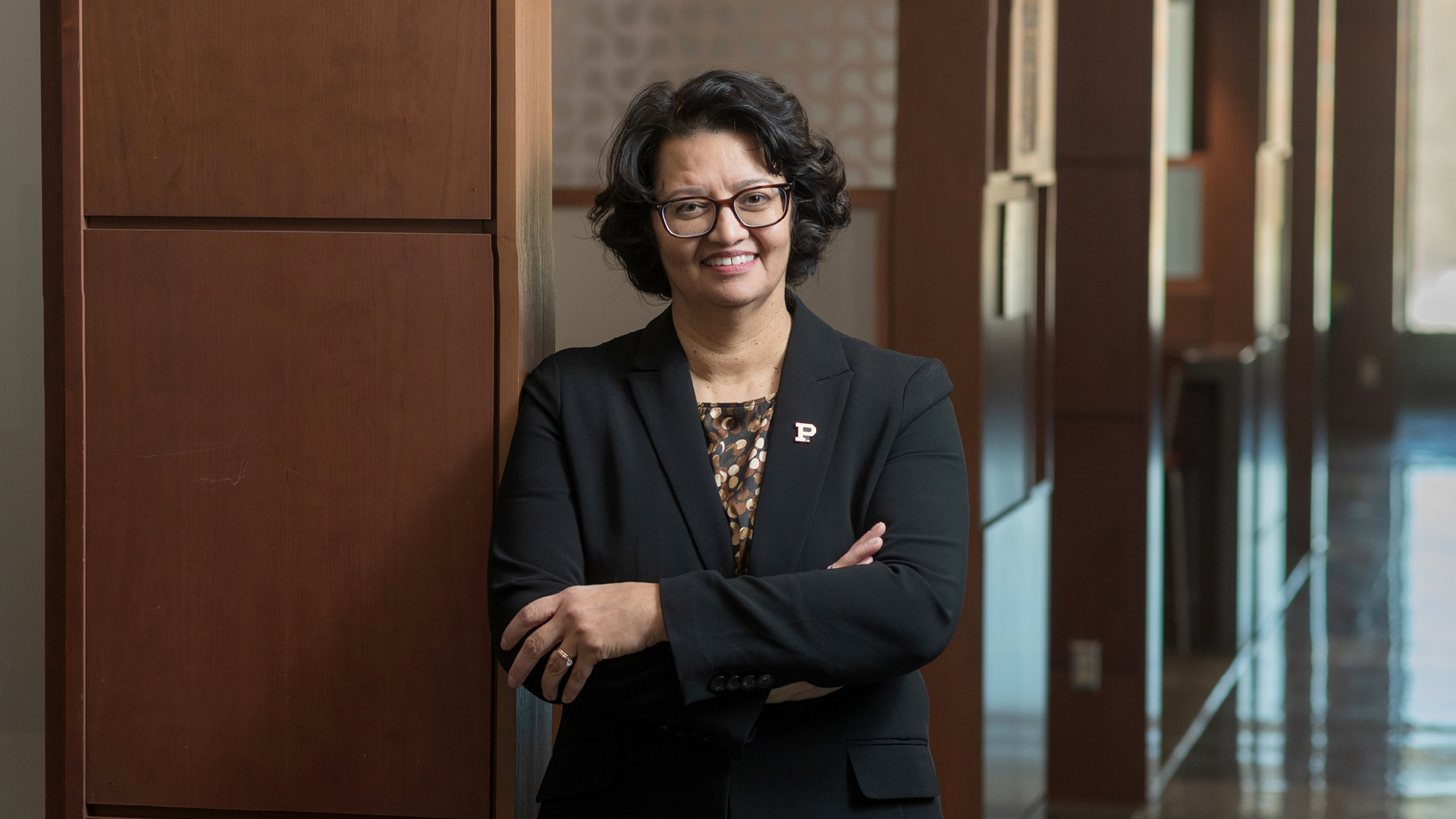Podcast Ep. 97: Greatest Hits of 2023: Celebrating Boilermaker Persistence
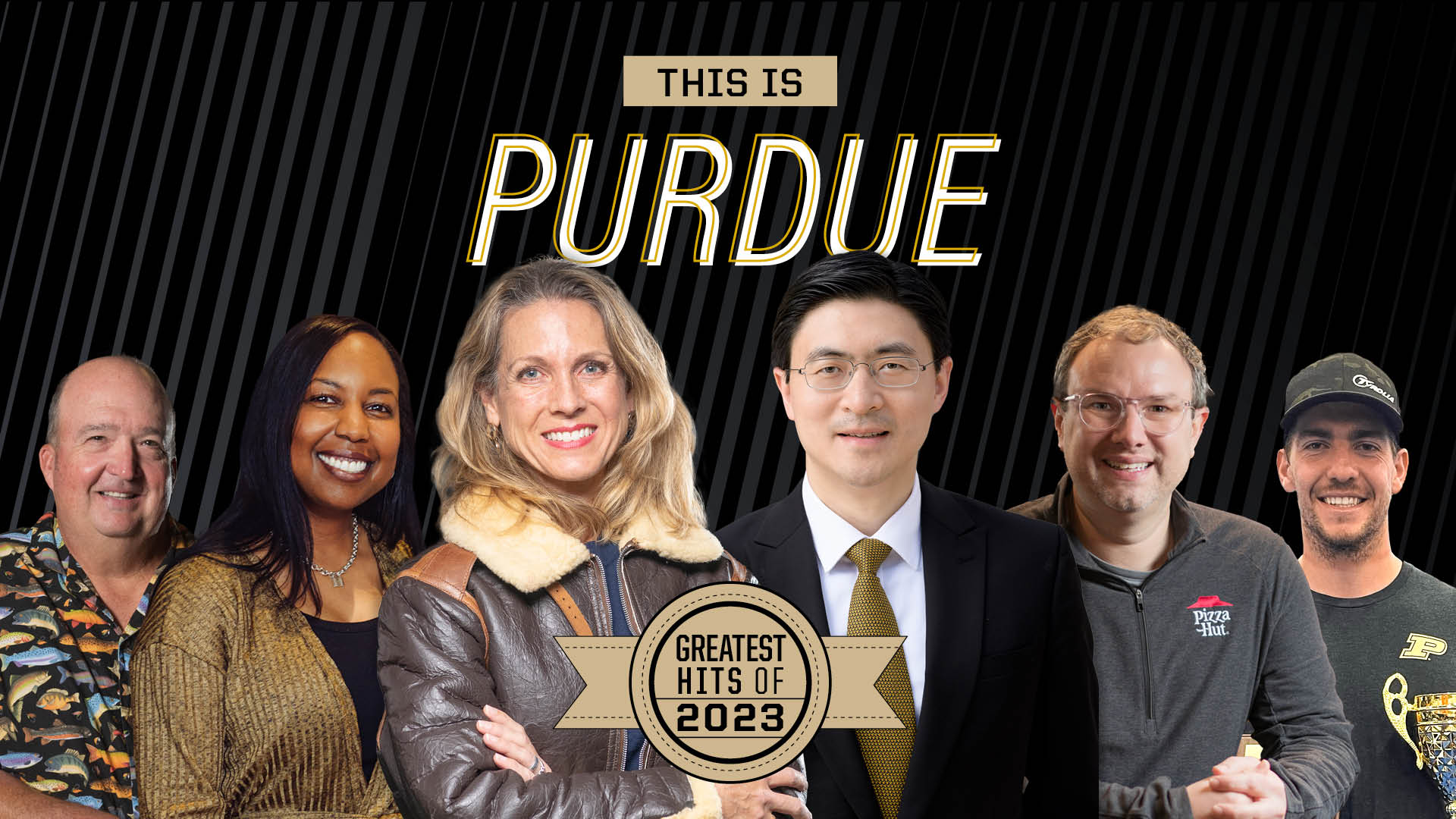
In this episode of “This Is Purdue,” we’re starting to ring in the new year with some of our most popular episodes from 2023.
Part 1 of our two-part “Greatest Hits of 2023” episode shines a light on the incredible stories and achievements of Boilermakers from across different disciplines.
Tune in as we share highlights from episodes featuring Purdue President Mung Chiang, fighter pilot Heather Penney, Pizza Hut U.S. President David Graves, Purdue deputy athletics director Tiffini Grimes, Team Penske IndyCar engineers Matt Kuebel and Mike Koenigs, and Purdue’s “Piano Man” Bruce Barker.
Celebrate the past year by listening to these Boilermakers who persistently pursue their next giant leaps. You don’t want to miss this one!
- Check out all of our “This Is Purdue” podcast episodes
- Subscribe to “This Is Purdue” on Apple Podcasts
- Watch our “This Is Purdue” video interviews and clips on YouTube
Full Podcast Episode Transcript
Kate Young:
Hi, I’m Kate Young and you are listening to This Is Purdue, the official podcast for Purdue University. As a Purdue alum and Indiana native, I know firsthand about the family of students and professors who are in it together, persistently pursuing and relentlessly rethinking. Who are the next game changers, difference makers, ceiling breakers, innovators? Who are these Boilermakers? Join me as we feature students, faculty and alumni taking small steps toward their giant leaps, and inspiring others to do the same.
Wow, it’s hard to believe 2023 is coming to an end. It feels like just yesterday the podcast team was working on our greatest hits of 2022 episode. Now, we’re highlighting some of our most popular episodes of 2023 to ring in the new year. Part one of our two-part greatest hits episodes focuses on some of the incredible Boilermaker persistence featured on This Is Purdue during the past year. Please join us for this journey as we reflect on six of This Is Purdue’s most listened to episodes of 2023.
Let’s start with a truly special episode that we actually kicked off the year with, our very own Purdue University President Mung Chiang. On January 1st, 2023, president Chiang, who previously served as the John A. Edwardson Dean of Engineering, and Executive Vice President for strategic initiatives at Purdue, took over for former Purdue President Mitch Daniels. We hit a number of topics in this interview, including the day he found out he would become the next president of Purdue, his family life and hobbies, and the best spot in West Lafayette to grab his favorite sweet treat, ice cream. Spoiler alert, president Chiang has a passion for ice cream.
We also discussed the meaning behind that special Boilermaker persistence and humility, and why the college experience should be both transformative and fun. Throughout the year, this episode served as a wonderful chance for all of our podcast listeners and viewers to get to know our president on a more personal level. President Chiang reflects back on the moment he was announced as the 13th president of Purdue University. Okay, so I want to take you back to a day that was probably a big day, a big moment for you when you were announced president of Purdue University. What were you feeling?
Mung Chiang:
Excited, grateful, and very honored. It truly is the most humbling and the highest honor that anyone I think in academia could imagine, because Purdue is not any other university. This is a special place, and because after the board of trustees’ unanimous vote, it just dawned on me the kind of responsibility that not just myself, but the whole team will continue to bear in order to advance this place. For 153 years now, coming 154 years, this place, generations of Boilermakers starting here, on the Wabash, and going all the way out to the surface of the moon. So many Boilermakers have been ever grateful, ever true to this special place, yourself included for doing this podcast now with us.
Each generation must carry on, as we would say, one brick higher. Because it’s already so high, the next brick higher is going to be even more challenging, but I’m so confident that together we will be able to excel at scale, and together we’ll be innovating continuously into the future, even when there are substantial changes coming our way, as always, one could argue to American higher education landscape.
Kate Young:
Is there a particular moment from that day that you remember best?
Mung Chiang:
Well, I tell you that I went home and told my children. My wife and I have three lovely children, and our eldest, the daughter, she insisted that it was a beautiful mistake.
Kate Young:
She didn’t have any faith in her dad?
Mung Chiang:
Well, you have to ask her that, but I’m just so glad that the board of trustees did not have to listen to her, unlike me.
Kate Young:
She was not part of the vote.
Mung Chiang:
No. But our middle one, he was relieved and excited that we’re going to stay in Indiana, and the younger one, she was only six at that time, just turned seven, and I think she on that day decided that daddy’s cool again.
Kate Young:
That’s the goals, right?
Mung Chiang:
Well, yes, that is. That’s the pinnacle of excellence as a father.
Kate Young:
President Chiang’s family is actually the first to live in Westwood Manor, home of our Purdue University presidents, with young kids. I asked President Chiang to share a bit more about his family and how they feel about this new life chapter.
Mung Chiang:
We will be living in Westwood. That is such a incredible blessing and a privilege. It is a university property. We happened to be given the honor to reside in this university property, and I was told, I need to check with the historians for accuracy, but I was told that this is the first time that Westwood in past 50 years, as presidential residents of this university, is going to have young children. There’s going to be a 7-year-old, and then a 9, 10-year-old, and a 15-year-old. It’ll be interesting to see if they cause a lot of property damage. It’ll be, I think, a lot of fun to live in the community as a family, to serve the community. My wife, Kei, she is an outstanding real doctor. She is an internal medicine physician, and absolutely the smarter one between the two of us, and a much better human being as well.
Kate Young:
Don’t worry, I’ll send this to her.
Mung Chiang:
Yes. Well, honey, if you are listening to this podcast, I just did state the fact that you are the much better human being between the two of us. Well, you’ve got to be nice to the boss. She is looking forward to this role as [inaudible 00:06:25] called the First Lady of Purdue, and being in Westwood, not only living there, but opening up the Westwood as a place for community engagement. She looks forward to, as a physician, serving and helping the local community, but also as part of our Boilermaker family, to engage with many different neighbors. She’s clearly excited about it.
As to the three, just mentioned that, very different reactions to the news, but one thing I made it clear to them now is that now you’ve got to behave even inside the house.
Kate Young:
Everyone’s watching.
Mung Chiang:
Ah, folks will be watching and they’re going to tell me. No, I hope that they will enjoy it and live their normal, regular life as kids growing up, but also recognizing what a special privilege it is to be there. They’re already all very much, [inaudible 00:07:22] has been for years now, big Boilermaker fans. My son for example, once said something funny. I was bragging about Purdue’s ranking. We’re most innovative. We are a top 10 public university. Engineering is ranked top five, and in fact the largest ever to be in some ranking in the top five in the country. Then he pat my back and said, “Dad, it’s okay. Don’t be sad.” I said, “What do you mean don’t be sad? We’re in final four, and there are like 300 of them out there.” He says, “Yes, might be number four, but in my heart, Purdue is number one.” That’s what he said. I said, “Well, there you go. That’s a Boilermaker.”
Kate Young:
Yes. When it comes to the word persistence, many of our This Is Purdue guests have all different types of creative and profound answers to what that specific word means to them. Here’s what it means to our Purdue University president.
Mung Chiang:
I’m sure there are dictionary definitions, and Wikipedia. I should ask Siri. Siri, what does persistence mean? I would give perhaps a somewhat unusual definition, a short one. Persistence to me means chasing after the infinite with what is merely finite.
Kate Young:
Expand on that a little.
Mung Chiang:
I know, that confuses me too. A lot of what we pursue as a university of knowledge, the creation of new knowledge and the broad dissemination, and I really mean broad,= for a place like Purdue, dissemination of knowledge. That is an infinite pursuit. It shall never end. There’s always something new we can do. Anytime Boilermakers are tempted by complacency, we always have chosen to aim even higher, to touch the surface of the moon. Yet we only have finite amount of time. Finite, whether it’s big or small, finite amount of resources. How do we pursue dreams that are infinitely far with what is merely finite? That I think is persistence.
Kate Young:
Okay, so I mentioned President Chiang has a special affinity to ice cream. Here’s his go-to dessert favorite on Purdue campus.
Mung Chiang:
I just preface my answer by saying that there are many different wonderful places, and to each person there’s a particular favorite spot and particular flavor. There’s no right or wrong here. Now, having said that, I do like the Gray coffee House.
Kate Young:
Greyhouse?
Mung Chiang:
Greyhouse. Now, you say, “But that’s a coffee house.” They do have gelato. Ah, see? Now we’re talking of something I’m revealing about our community. They have a gelato counter to the side, and my favorite is what they call affogato. Somebody gave me a lesson some years ago that is apparently Italian, that says you are drowning gelato, a flavor of your choice, with espresso. Now, the nice thing about that, if you’re talking about chemistry now, we’re talking about usually espresso, you want some sugar, you want some cream, and you want to cool it down a bit. Well, you’ve got all three in the ice cream already, so you don’t have to add anything, and you’re drowning gelato with espresso. I usually would pick a gelato, because you’ve got to do the pairing, right?
Kate Young:
Right, yes. What’s the flavor?
Mung Chiang:
Without espresso, the flavor could be, say I like dark chocolate. But that doesn’t quite work for my taste buds. It might work for yours with affogato. I usually go with very plain one, say vanilla. Fruity ones doesn’t work. Sorbetto doesn’t work. Say, a vanilla bean gelato drowned by a double espresso. That’s going to get you going for the rest of the day.
Kate Young:
We can’t thank President Chiang enough for spending time with us on our official university podcast, and sharing more about his family and what Purdue University and this Boilermaker community means to him. Remember, you can listen to the entire episode if you go to purdue.edu/podcast, or you can watch our full video interview with President Chiang on our podcast YouTube channel, youtube.com/@ThisisPurdue.
Next up is an incredibly unique story that is sure to give you goosebumps. What you are about to hear is like a story straight out of a movie, but it’s the story of a real life Boilermaker. Our podcast team had the opportunity to interview former DC Air National Guard Fighter Pilot and Purdue College of Liberal Arts alumna, Heather Penney, inside a Purdue airport hangar. When she was just 26 years old, heather embarked on a flight on September 11th, 2001 that would ultimately change her life. You’ll hear a piece of her story here soon, but first, Heather shared her gratitude for her time as a student at Purdue, where her passion for flying blossomed further, and her experience training to become one of the nation’s first female fighter pilots.
See, in 1996, the DC Air National Guard invited Heather and nine other pilots to interview out of a field of more than 300 applicants. From there, they selected only two, and one of those two was Heather Penney. Heather went on to train to become one of the first American women to fly the F-16, and her training class’ only woman. Heather shared her 9/11 story with us during this interview. She reflects on the events of that historic day.
Heather Penney:
That morning on September 11th was like every other American that morning. It was totally ordinary and everyday. I woke up, put my flight suit on, I ate my Cheerios, I kissed my dog goodbye, and I drove off to work. There was nothing special about that day. But I do remember on the east coast in DC, and it was in New York as well, how crystal blue the sky was. Not a cloud, no haze. It was deep and blue as far as you could see.
Kate Young:
No idea what was about to happen.
Heather Penney:
No one had any idea what was going to happen.
Kate Young:
Tell me about when you got that call. What were you feeling? How did that obviously change your life?
Heather Penney:
We were in a scheduling meeting. I was not scheduled to fly that day, although I desperately hoped that I would have, because I loved flying. I was a young wingman. It was my job to fly, fly, fly. But I’m in a scheduling meeting. One of our enlisted troops, David “Chunks” Callahan just comes walking in and says, “An aircraft hit the World Trade Center.” We all got up and we walked to the squadron bar where our television was, and that’s where we saw the images that everyone else saw, of the towers burning, and the replay footage of the airliners hitting the towers.
We knew we had to get airborne, and we knew we had to protect, but the problem for us was that as the DC National Guard, we didn’t have the chain of command that could authorize us to launch. The other problem is that because we were not on an alert unit, the United States after the fall of the Soviet Union had just cut the Air Force in half literally, and dropped all of our alert units. We didn’t have any missiles. We had no live ordinance on board, so we had two problems. We had to get the authorization to launch, and we had to get live weapons on the aircraft.
Kate Young:
Did anyone ever think it was an accident maybe that someone flew into the World Trade Center? You guys knew?
Heather Penney:
When Chunk said the first time, “Hey, an airplane flew into the World Trade Center,” we looked at each other, and we’re like, “How does that happen?” We thought it was a light aircraft just flying up and down the Hudson, and took a wrong turn, and bounced off a building. We didn’t take it seriously until he came back the second time and said it was on purpose. That was when we saw the images. It was very clear this could not be an accident. It was very clear that our nation was under attack.
Kate Young:
How did they choose who was going to go up there? How were you chosen to do that?
Heather Penney:
In the squadron that morning, we had a very skeleton crew because we had just come back from a long deployment, and as a guard unit, most of our pilots were part-timers, so they’re airline pilots. They were off on their jobs. As a matter of fact, we only had enough personnel in the squadron to send a three ship. We normally send eight ships off to train that morning.
Marc Sasseville was our director of operations. He was our senior leadership within the squadron that morning, and he was not going to let anyone else lead that mission because when the call came, we knew it was going to be a suicide mission if we were successful. He has a gorgeous wife and wonderful, adorable children, but he was not going to lead from behind. I would love to think that he picked me because I was a good wingman, but I think honestly he probably picked me because I had no family. I didn’t have a spouse, I didn’t have any children. All I had was my dog. I think that was why he chose me, because he told “Raisin” Dan Kane and Brandon Rasmussen, his call center was “Igor”, and they both had families, they were to wait until they had missiles on board. I believe that’s why Sass selected me.
Kate Young:
How did you feel when he selected you? What was going through your mind?
Heather Penney:
I did not want to get left behind. None of us did.
Kate Young:
Everyone was eager to go?
Heather Penney:
Everyone was eager to protect and defend. That is our oath. That’s why we exist. I was grateful that he selected me.
Kate Young:
What did it feel like getting in that plane that day?
Heather Penney:
Can I say this?
Kate Young:
Yeah.
Heather Penney:
“Don’t f*** it up.” If anything mattered at that moment in time, it was getting it right. I wasn’t trained for this. We don’t train to do suicide missions. I had never been taught how to scramble an airplane, and since then obviously I have, because we now have an alert unit, but the airplanes weren’t ready. They weren’t hot cocked, so we had to make up our procedures on the fly. I was taxiing, my radar wasn’t awake, my missiles weren’t awake. I didn’t have a navigation platform. I wasn’t even strapped into the jet, so I couldn’t have ejected. I didn’t even have my seat belts on. But all that mattered was that we got out there as soon as we could and that we found the airliner that we believed was inbound. Unfortunately, the passengers on flight 93 had already taken control of the airliner, and had already crashed it.
Kate Young:
What was going through your mind when you knew that it was a plane crash, and you couldn’t do anything more about it?
Heather Penney:
We didn’t find out that flight 93 had been downed. Sass took us out, I don’t know how far, because I didn’t have navigations, but probably a little over 100 miles. We went out to the northwest over the Pennsylvania countryside. We didn’t see any smoke, which is surprising because we should have, but I don’t recall seeing any smoke, and then turned us around, because we had sanitized the airspace.
We couldn’t afford to go any further out, because if we were even just a little bit off on our axis, we could have allowed the airliner to flank us and we didn’t know that it was down. Once we had sanitized the airspace from the direction that we believed the airliner was coming from, Sass took us back to DC to fly the combat air patrol. Then we set up a combat air patrol with the counter rotating cap centered over Reagan National, and then the quits from Langley. Some F-16s who were flying alert from Langley showed up. They capped up at 18,000 feet and they had missiles, so then my anxiety started to go down. Igor and Raisin got airborne, and so then we switched up the cap from there. Potomac approach was phenomenal.
This is just an amazing story of how ordinary people rise to extraordinary circumstances, stealing that quote from Admiral Halsey, “Bull” Halsey from World War II. Potomac Approach is air traffic control, and their normal job is to separate airliners and put them all on little highways to take them down for safe landing. Now, here Sass and Raisin are asking air traffic control to bring aircraft together, and start talking fighter pilot language, and using military speak, and they pivoted and did that immediately. They were so mentally agile, and then they started calling out tracks and telling us who they were and where they were going. They helped make sense of what was a confusing airspace, and they were just utterly fantastic. How people pitched in and began to make it all work, even though none of it was planned, it was all ad hoc, but people just did what needed to be done.
Kate Young:
I’m sure after hearing this, it wouldn’t surprise you that our entire podcast team was in absolute awe of Heather and her story. It was so silent in that airport hangar, you could hear a pin drop. We were all mesmerized and we can’t thank Heather enough for sharing her story on This Is Purdue. To end our conversation, I asked why this brave, relentless, heroic Purdue alumna was proud to be a Boilermaker.
Heather Penney:
Why wouldn’t I be proud to be a Boilermaker? All the things that we’ve talked about, what a Boilermaker means, what Purdue means, everything that we stand for, the excellence, the research, the innovation, the creativity and the thought. Also, if you look at just how Purdue is trying to make education affordable to the broader population, and keeping the costs down, that to me is an important piece of the legacy as well, is just that pragmatic view of how we can take education, make it available and accessible to people so that they can grow in their own lives and their own future.
There’s so much about Purdue that is meaningful to me, not just because of the legacy and the heritage that we’ve come from, but what they’ve done since I’ve graduated and the direction that Purdue is going. It’s exciting to be able to call this my alma mater, and exciting to be here, being honored by Purdue, by the College of Liberal Arts as a distinguished alumna, and exciting to see where the university is going. You go out and you meet these kids and you go, “Man, they’re going to go do great things for this world.”
Kate Young:
Heather shared so much more in this episode about her Boilermaker experience, her call sign, “Lucky,” and her feature as part of the Big 10 Networks Trailblazer series, and you truly don’t want to miss out on watching this airport hangar interview experience with Heather. Head over to our podcast YouTube page, youtube.com/@ThisIsPurdue, to see the full video interview.
Our next episode features something we can all relate to, food. David Graves, President of Pizza Hut US, is a Mitchell E. Daniels, Jr. School of Business alum. Okay, this was one of my favorite episodes of the year because our podcast team got to take a little field trip. The team went to meet David in his element, right inside a Pizza Hut in Lebanon, Indiana. Not only did we get to chat with the president of Pizza Hut US, we also got to watch him in action, helping to make his favorite pizza back in the kitchen. Here’s David on how he got involved in the food and restaurant industry. Plus, you’ll hear the behind the scenes details of Pizza Hut’s history and David’s favorite pies.
David Graves:
I think everybody loves food. I love food. We’re in a restaurant. Think about, I’m blessed to sell pizza. When you talk to people, I tell people, “Hey, I sell pizza.” I have 11-year-old daughter, and her friends come over and they think that I work at pizza is the coolest thing, and we talk about new pizzas that could come out. Everybody loves food, and I’m no different. I love cooking. I have a bad habit of collecting cookbooks and reading them like real books. I think my wife would like me to have a few less cookbooks.
Really for me, I had been at Proctor and Gamble for a while. I was starting to think about doing something different, and this opportunity came up back in the Midwest at KFC, which is this iconic brand that I had grown up with and it was like this opportunity to go reimagine this brand. I just thought, “That sounds cool. That’s really fun, and I love food. Let’s go for it.” That’s how I ended up coming into the restaurant industry.
What I’ll say that I don’t think I appreciated fully at the time is, the restaurant industry, everybody loves food. Lots of people that come into the restaurant industry, they love food, but it’s really a people industry. You have this incredible opportunity to impact people, both through giving them delicious food, and connecting people through the joy of food, but also building careers and developing people. When you talk to people that are in the restaurant industry and they’ve been there for a long time, the thing that you’ll find is, the thing that keeps people there is really the people. It’s a people industry, and frankly, that’s what makes it a lot of fun because you can connect with people, impact people, and build incredible relationships.
Kate Young:
David’s right. Most people love food, including me. I love the connection you feel going to a restaurant to catch up with friends, or having a fancy date night to celebrate something big. Most people out there love pizza. There’s usually so many memories tied to pizza too, when you really think about it. Childhood birthday parties, going out for a good report card, late nights in college, and then much earlier nights in adulthood when you simply just don’t feel like cooking. As I mentioned previously in this episode, our This Is Purdue podcast team had the chance to go behind the scenes in this Lebanon Pizza Hut kitchen with David himself.
David Graves:
Should we go back and check these things out?
Speaker 6:
Yeah. We got a large [inaudible 00:25:02] of half cheese, half [inaudible 00:25:03] just come out on top. We’ve got a large hand-tossed Hawaiian down here for-
David Graves:
That’s yours.
Speaker 6:
There you go.
David Graves:
Pineapple belongs on pizza. That’s what-
Speaker 6:
I agree. I’m a connoisseur.
Kate Young:
I agree.
Speaker 6:
I would’ve agreed. If it would’ve had barbecue it would’ve been better.
David Graves:
Oh, there’s a Big New Yorker coming out.
Speaker 6:
We put out a big New Yorker out there for you. Why not do that? Then I heard this one is your personal favorite, with the pepperoni, the jalapeno, and lots of cheese for you.
David Graves:
Look at it when it comes to Kurt [inaudible 00:25:28]. See, this is why you’ve got to get it right out of the oven. You see, it’s bubbling.
Kate Young:
Oh my goodness. A little background on Pizza Hut. In 1958, two brothers borrowed $600 from their mom to open a pizza place in Wichita, Kansas. They named it Pizza Hut because their sign only had room for eight letters. Today, this iconic pizza brand has more than 16,000 restaurants and 350,000 team members in more than 100 countries.
David had the team try a few different pies, including the 16-inch New York style pizza, the Big New Yorker, which recently returned to their menu after its initial launch 24 years ago. From thin crust, to hand tossed, to the iconic pan crust, to new innovations like their Pizza Hut Melts, a cheesy, crispy melt loaded with toppings and paired with a dipping sauce, our team had the chance to sample quite a bit. By the way, we were eating these delicious creations at around 10:00 AM, but nobody seemed to mind.
Speaker 7:
[inaudible 00:26:28] on the way. We got a Pepsi product, so Pepsi, Mountain Dew, Sierra Mist, lemonade [inaudible 00:26:35], and the peach sweet tea, and a coffee, and a wine and beer. [inaudible 00:26:37].
David Graves:
It’s 10:20 in the morning. This is probably the earliest you’ve ever eaten pizza.
Kate Young:
Amazing.
David Graves:
I’m going to try this one too, because this is, we just launched this yesterday.
Kate Young:
Oh, is this the New Yorker?
Speaker 7:
This is your water for you, okay?
Kate Young:
Thank you so much.
Speaker 7:
You’re welcome.
David Graves:
People are loving it, but I haven’t been home, so I haven’t tried one from a store yet.
Kate Young:
Look at how big that piece is. Now, all of it was delicious, but when I had a bite of that simple classic cheese pan pizza, the memories came flooding back. Does anyone remember Pizza Huts Book It program from elementary school? I sure do. The Book It program is the nation’s longest running corporate supported literacy program and impacts more than 14 million students each year. What’s the crust difference between when we’re looking at all these?
David Graves:
This is a hand tossed, hand stretched, hand tossed dough. Thin crust is obviously a really thin, crispy crust. This is stretched by hand to the size. This is a 16-inch pizza that they stretched, and then that’s pan dough. Pan dough is proofed dough that raises, so they put it in a proofer, it raises overnight, and then that’s how you get this big, big pan dough.
Kate Young:
This reminds me of childhood.
David Graves:
Yeah, this is the iconic Pizza Hut Pizza, but what people don’t know is that, that and personal pan pizzas right through Book It, but the thin crust is the original pizza that started. The very first Pizza Hut in Wichita that the Carney brothers started on was the thin crust pizza.
Kate Young:
Why is this Purdue alum proud to be a Boilermaker?
David Graves:
It’s an incredible place that prepares incredible leaders. You look at the types of things that have been accomplished by Boilermakers all over the world. To be able to be a part of that community is really a privilege.
Kate Young:
Be sure to check out this full video interview on YouTube to see our interview with David right inside Pizza Hut. Plus, he dives into how Purdue prepared him to work on global brands such as Pampers, Pantene, and KFC, his favorite advertising and marketing initiatives over the years, including working with actor Craig Robinson of The Office, and using Pizza Hut’s brand nostalgia to bring its marketing into today’s modern age. You don’t want to miss it.
Next up is our now annual Indianapolis 500 themed episode. You may remember our interview back in May of 2022 with Purdue Mechanical engineering alumna, Angela Ashmore. This Boilermaker made history as the first woman to win the Indianapolis 500 as a member of the winning car’s crew, after driver Marcus Ericsson won the 106th running of the Indy 500 in the Chip Ganassi racing number eight Huski Chocolate Honda. This year for 2023, we knew we had to interview another Purdue alum who was involved in the Indy car circuit, and we actually had the opportunity to interview two alums, Mike Koenigs and Matt Kuebel.
Okay, can I just put this out there? I truly think this podcast is good luck because, you guessed it. The Indy car team Mike and Matt work for, the legendary team Penske, won the 2023 Indy 500 with their driver Josef Newgarden. This Is Purdue is two for two here. Matt, who graduated in 2022 with his mechanical engineering degree, and Mike, an aeronautical and astronomical engineering alum who graduated in 2003, discussed their Purdue College of Engineering journeys and what it’s like working for one of the most well-known iconic teams in motor sports. These two Boilermakers worked on all three team Penske Indy car entries that competed in the 2023 Indie 500 at the Indianapolis Motor Speedway, Josef Newgarden, Will Power, and Scott McLaughlin. Here’s Matt, who is a design engineer for Team Penske on the emphasis placed on the Indy 500.
Matt Kuebel:
I do know that it means a lot to a lot of people to win the 500. It is just such a special thing, and for it to be in Indiana, the historic factor of the 500, just the worldwide well-known aspect of it. You could talk to anybody from in the motor sport world, not even US, but they know about the Indy 500. They will know who wins the Indy 500. To be on a team that has a chance to win the Indy 500, it makes me feel very, very … It makes me feel really good. I definitely wouldn’t have got here if I wouldn’t have chosen to go to Purdue.
Kate Young:
Here’s Indy car veteran and Team Penske aerodynamicist Mike, explaining why the Indy 500 is the pinnacle of professional motor sports races.
Mike Koenigs:
Indie 500 is a special race, in of it is how hard it is to win, and how many people try. The amount of effort and work that goes into it is pretty intense. One, we are successful, and I’ve been successful handful of times. It is pretty special in terms of which driver wins it, because we know them personally, and you know that a lot of them have been striving for long term in their careers. It’s basically, especially here, it can be a career pinnacle achievement. It’s special for everyone, but here it has that little bit more of a significance, and just knowing the amount of work that all the guys do.
I don’t know other teams are, but we have a fair amount of interaction with mechanics, and the truck drivers, and all the support staff, and everything that goes into the car, from the people in the car shop to our painters. From that standpoint, every day you see how much work everyone puts into it, and it is a truly collective effort. From that standpoint, it is really satisfying. Sometimes, you may be completely exhausted as we watch the race with all the effort you put into it, and you may not have the right perspective in what you’ve done or whatever and feel satisfied, but you are always satisfied for everybody else, and you’re always happy for everybody else as well.
It is a large amount of celebration for it, and personally, it’s been a pretty high pinnacle of achievement for me, and to be happy to be part of so many wins. But then at the same time, like I was saying, we essentially turn the page Monday, and start focusing on next year, and try to figure out what we didn’t do right this year and try to improve upon that, and what we did right, we try to magnify or amplify for the next year.
Kate Young:
Be sure to go back and check out the full episode so you can hear more from these Boilermaker Indy car engineers. You’ll hear more about the persistence, grit, and attention to detail required to be part of a winning Indy 500, team and how their Purdue education set them up for success in the professional motor sports world. Stay tuned for who we interview in 2024 because, you never know. We just may feature someone from the Indy 500 winning team for a third year in a row.
Our next episode features a woman whose Boilermaker pride shines every day. Tiffini Grimes is a proud Purdue alumna, and Purdue’s deputy athletics director and senior woman administrator. In this interview, Tiffany shared more about her career journey, as she made her way from law school and then worked in athletics departments for universities like Georgia Institute of Technology, Penn State University, University of Alabama, and finally back home to Purdue. Tiffini, who was named part of Sports Business Journal’s 40 Under 40 Class of 2022, and part of The Athletic’s College Sports 40 Under 40 list, shares advice on what she would say to other women who are pursuing careers in fields that are still traditionally male-dominated.
Tiffini Grimes:
I don’t think it should be a barrier. Sometimes I wonder, we talked about this at the Purdue Women’s Network breakfast, and I wonder at times if the barrier is in our own mind. Part of it, and again, I credit my parents because I didn’t even know that that should slow me down. Not that I haven’t faced it, not that I haven’t seen it as plain as day, but in my mind, I think, “That’s a you problem. That’s not a me problem.” I can sit at the table, I’m going to be just as prepared as my male counterparts. I’m going to be just as cerebral. I’m going to be just as innovative, and in some cases, probably more.
You have to make sure you come to the table with substance and credibility. Anyone who thinks that, “I shouldn’t be there because I’m a woman,” that’s a them problem. That’s not on me. That’s how my family taught me to think. I also think that plays into not taking no for an answer. It really plays into a competitive mindset and a championship spirit. You lose a game. That doesn’t define who you are. That means we work harder, we find another way, we don’t get complacent. I use all of those thoughts and that perspective to forge me ahead.
What I will say, is that I take the responsibility with great honor. Just because I feel that it’s not a barrier, doesn’t mean that the next woman does, or that that individual is at a space in her career where she could say something about it if it became too much of a barrier. Making sure that I’m always checking in on the women in our department, and finding and trying to identify opportunities for them to develop and grow is something that I take very, very seriously.
I will say this, what I have found in the past seven years is that actually being a woman is my superpower. There is not one table that I feel like I don’t belong at anymore. Part of that is the confidence that Purdue instilled in me, and my family instilled in me, but when I sit in these spaces, what I realize is that there are things that I can say to our male coaches, and staff members, and our male student athletes that my male counterparts just can’t.
Kate Young:
Another theme Tiffini touched on was the balance between Purdue’s world-class academics and excellent athletics culture.
Tiffini Grimes:
We play sports for the day that we can, and this is a talent that a lot of young people, we have over 500 student athletes. It’s a talent that they have and they’re able to utilize their talent to obtain what I believe to be the best education in the country, in the world, for that matter. Then, when the ball stops bouncing, when you’re not on the track anymore, when you’re not taking a lap in the pool, what do you stand with? I think a Purdue degree is a pretty great thing to have, to forge you ahead the next 40, 60, 70 years of your life.
Kate Young:
As for being back at Purdue, surrounded by the Boilermaker spirit, Tiffini shares her thoughts on why Purdue is such a special place.
Tiffini Grimes:
The people. It boils down to the people. Never before have I seen or worked at an institution where the line for students is two hours backed up before gates open. Never before have I worked at an institution where you aren’t trying to strategize with marketing on how to get your students to stay for four quarters. It’s just the Purdue way, and our students and our supporters are kind and good fans. A lot of sportsmanship at Purdue, a lot of class at Purdue, but we’re going to be unapologetic about cheering on our team. We’re not going to disrespect yours, but we’ll cheer for ours louder than you ever imagined. I think that’s what makes it really special.
I’ll add to that, it’s also a special place when you see alums that are bringing their families back for the first time and introducing their children into a place where they had so many amazing memories as a student. I also think it’s great when we gain new fans that have no prior affinity or connection to the institution, but athletics has this ability to be, for lack of a better phrase, the front porch of the institution. Every time the black and old gold is on display, in whatever sport it is, that’s a national audience. If our number one ranked men’s basketball team can introduce Purdue to some young person who’s looking for a top national university, then that’s a lot of pride. That’s a lot of pride and a great responsibility that I think we have. We feel honored to hold.
Kate Young:
Check out Tiffini’s full episode by visiting purdue.edu/podcast to hear more. She discusses the deep pride she feels in pursuing her next giant leap at her alma mater, why working with Purdue’s student athletes on their experiences both on and off the field is so special to her, and much more.
Bruce Barker:
(Singing) Love you, boilermakers.
Kate Young:
Finally, you didn’t think we could have an episode of our greatest hits without including Purdue’s Piano Man, did you? Our Bruce Barker episode came out in October, and it was an extra special episode for a few reasons. One, the podcast team was able to go onsite and interview Bruce in his element at the Neon Cactus. Two, our team also got to attend his live show later that night, and three, this Boilermaker legend is retiring at the end of 2023. We had the chance to celebrate his career and the impact he’s made on so many Boilermakers over the past 30 years.
Now, if you haven’t been to one of Bruce’s shows before, or maybe it’s just been a while and you need a refresher, this Purdue alum plays the piano and sings popular songs from pop to country to rock and roll. But these aren’t your average throwback songs. See, many of them have a Bruce Barker twist. Like “Wagon Wheel”, for example. There’s an addition that show goers like to add to the course.
Bruce Barker:
(Singing). Who’s loving it? (Singing) I think they’re singing about your date there, Kate.
Kate Young:
Yes, you heard that right. I just got very publicly shamed by the piano man himself for marrying an IU Hoosier. Yeah, I guess I deserve it. Then there’s the late Jimmy Buffett’s “Margaritaville.”
Bruce Barker:
(Singing) We’re all clapping. We’re clapping and singing. (Singing) Whose fault is it? (singing)
Kate Young:
Another one of Jimmy’s songs, “Come Monday.”
Bruce Barker:
(singing)
Kate Young:
In this episode, Bruce reflects on the time he realized his shows at the Neon Cactus were becoming quite popular.
Bruce Barker:
It used to be like the first night when I made 17 bucks. You hoped that people would just keep trying you out, but there became a time when you get here at 7:00, and the lines are already formed, and you’re like, “They’re not here because of the drink specials or they want to run to the dance floor.” What an amazing, and I know you don’t know me very well, but I hope that I come across as humble because I’ve always just been so thankful and appreciative that a thousand people on a Thursday plan their night around me. What an amazing, amazing gift and blessing.
Kate Young:
Bruce also shared his thanks to his beloved fans as he reflects on retiring at the end of this year.
Bruce Barker:
Again, there’s no way to say thank you enough. There’s no words, but I hope that I have conveyed to them just how much I’m thankful, and I am a Boilermaker. I bleed gold and black. I will die a Boilermaker, and I’m so blessed to be a Boilermaker, so I really can’t say thank you enough to them for accepting me and giving me the best job ever.
Kate Young:
Be sure to check out this full episode wherever you get your podcast, to hear more about Bruce learning to play the piano for the first time, his Varsity Glee Club experience, favorite moments performing at the Cactus throughout the years and so much more.
I hope you all enjoyed reflecting on some of our favorite moments from the past year as much as our podcast team did. Now, be sure to tune into part two of our greatest hits of 2023 on Thursday, December 21st. That episode will highlight our inaugural research series, so you’ll hear snippets from each of the four research series episodes. We want to hear from you. What was your favorite This Is Purdue episode from the past year? Share a review on Apple Podcasts, or tag us on social media, @LifeatPurdue, and use the hashtag #ThisIsPurdue, and you could be featured in an upcoming episode.
This Is Purdue is hosted and written by me, Kate Young. I want to give a special shout out to every Purdue team member who was a part of the podcast throughout this past year. Our podcast videography is led by Ted Shellenberger in collaboration with John Garcia, Thad Boone, Zach Mogenson, Alli Chaney, Matt Kerkhoff, and Jonathan Hord.
Our social media marketing is led by Maria Welch and Ashley Schroyer. Our podcast distribution strategy is led by Teresa Walker and Carly Eastman. Our podcast photography is led by John Underwood and Rebecca Robinos. Our podcast design is led by Caitlin Freville. Our podcast team project management is led by Rain Gu and Emily Jesulaitis. Our production assistants is led by Dalani Young. Our podcast YouTube promotion is managed by Megan Hoskins and Kirsten Bauman. Additional writing assistance is led by Joel Meredith. Podcast research is led by Sophie Ritz, and our This Is Purdue intern is Carolyn [inaudible 00:45:49].
Thanks for listening to This Is Purdue. For more information on this episode, visit our website at purdue.edu/podcast. There, you can head over to your favorite podcast app to subscribe and leave us a review. And as always, boiler up.
